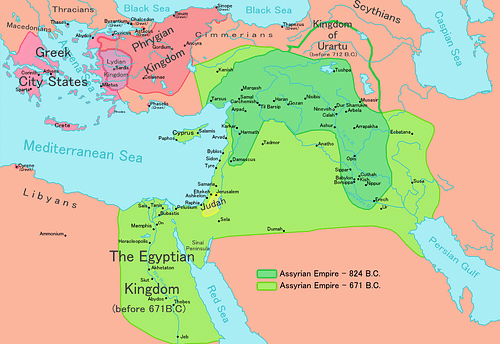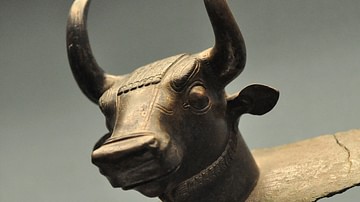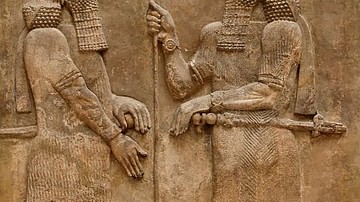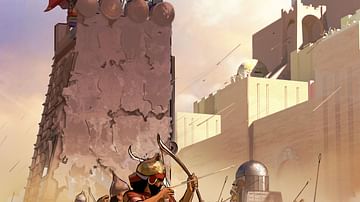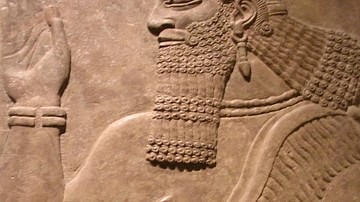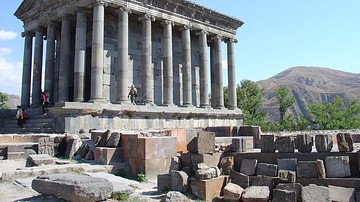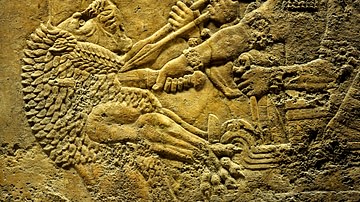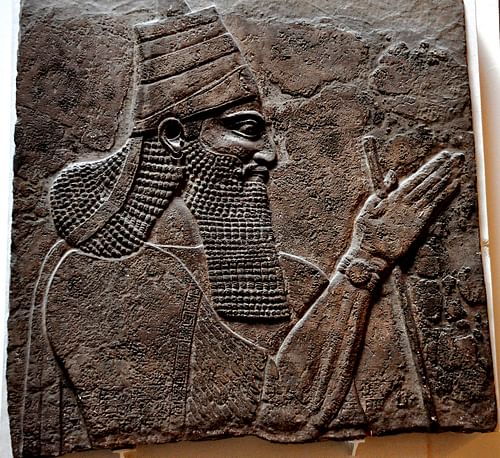
Tiglath Pileser III (745-727 BCE) was among the most powerful kings of the Neo-Assyrian Empire and, according to many scholars, the founder of the empire (as opposed to the claims for Adad Nirari II (912-891 BCE) or Ashurnasirpal II (884-859 BCE) as founder). His birth name was Pulu (or Pul, as he is called in the biblical books of I Kings and I Chronicles). His assumed name, Tiglath Pileser III, is the Hebrew version of the Akkadian Tukulti-Apil-Esara and was chosen to link himself directly to great kings of the past, such as Tiglath Pileser I. He took the throne in a palace coup and was not of the royal line, although it seems he was of royal blood. Prior to his rise to power, the Assyrian Empire had been languishing under kings like Ashur Dan III and Ashur Nirari V, and the regional rulers had acquired enough power to act autonomously. Following his coup, Tiglath Pileser re-organized the government, curtailed the power of the provincial rulers, re-structured the military, and revitalized the empire. Under his reign, the Assyrian Empire expanded and populations were forcibly re-located throughout the region to maximize the efficiency of the communities and discourage revolt. He was an adept administrator and is regularly regarded as one of the greatest military leaders in history.
Rise to Power & Early Reign
Pulu was a provincial governor of the city of Kahlu (also known as Nimrud), which had been the capital of the Assyrian Empire since the reign of Ashurnasirpal II. Dissatisfaction with the laconic rule of Ashur Nirari V had reached a crisis point by the year 746 BCE and civil war broke out. Pulu's faction defeated the forces of Ashur Nirari V, seized the palace at Kahlu, and slaughtered the royal family. It is unclear whether Pulu initiated the revolt, but he either won the support of court officials to mount the uprising or took command once it was underway; in either case, he claimed the throne after the death of the king and assumed the name Tiglath Pileser III.
The autonomy of provincial governors had grown enormously under the rule of the past two kings of the empire. The historian Van De Mieroop writes:
In the first half of the eighth century, Assyria had lost its ability to campaign outside its borders and internally local officials had usurped some of the royal powers. Provincial governors were able to act with a great deal of independence, although they still had to acknowledge their subservience to the king. Scholars disagree about the extent of internal weakness: some see the local officials as virtually autonomous, others consider them as fully integrated within the Assyrian state structure and their activities as coordinated with those of the king (248).
Since Tiglath Pileser III had been one of these government officials and had managed to topple the king, his first priority was to make sure the same thing did not happen to him. He restructured the government to place more power in his own hands and drastically reduce the authority of local governors. He reduced the size of the provinces, increasing their number from twelve to 25, and divided the responsibility for governing between two men who had to agree on policy before it was brought to the king (as opposed to the old form in which one powerful governor was free to do as he pleased). He also initiated a policy in which he appointed eunuchs to these positions so there would be no provincial dynasties and the position could not be passed from father to son, thus decreasing the likelihood of a governor trying to usurp too much power, since he would be unable to establish a family line to carry on his name (Van De Mieroop, 248). He also instituted an intelligence system which was carefully overseen by the palace and those the king could trust. Tiglath Pileser III's administrative talents and understanding of human motivation were crucial elements in the success of this re-organization of the empire.
Having secured his position and stabilized the government, he next turned his attention to the military, which also underwent drastic reformation. Previously, the army had been made up of conscripts who were forced to fight, often against their will, and primarily in the summer (the traditional time for campaigns as the crops would have already been planted and the harvest was still ahead). The new king changed this policy so that now there was a levy of a certain number of men each province had to provide who would be thoroughly trained to be a member of the Assyrian army and could campaign year-round. In doing so, Tiglath Pileser III created the first professional army in history.
Military Campaigns
According to the historian Gwendolyn Leick, Tiglath Pileser III “was a tireless campaigner, leading his powerful army for every year but one of his 17-year reign. He began by subduing Aramaean tribes in Babylonia, where he garnered support on a grand tour of the major sanctuaries” (172). Once the king of Babylon had sued for peace, Tiglath Pileser III left the city alone and paid homage to the gods of the land at the temples (as Leick alludes to regarding the `grand tour'). He then marched north to defeat the kingdom of Urartu, which had long been a powerful enemy of the Assyrians, in 743 BCE. With Urartu under Assyrian control, he then marched west into Syria and punished the kingdom of Arpad, which had been Urartu's ally, in 741 BCE. He lay siege to the city for three years and, when it fell, he had it destroyed and the inhabitants slaughtered. He then divided Arpad's kingdom into provinces under the rule of Assyrian governors (who were eunuchs, as per his policy) and deported huge segments of the population to other regions. Although Tiglath Pileser III is commonly cited as the Assyrian king who first instituted the policy of deportation, it had actually been instated by Adad Nirari I (1307-1275 BCE) centuries before and had been common practice, for those kings powerful enough to employ it, ever since. Tiglath Pileser III's methods of deportation are in keeping with those of his predecessors who made sure that the deportees were well cared for and equipped for their journey. The historian Karen Radner comments on this, writing:
The deportees, their labour and their abilities were extremely valuable to the Assyrian state, and their relocation was carefully planned and organised. We must not imagine treks of destitute fugitives who were easy prey for famine and disease: the deportees were meant to travel as comfortably and safely as possible in order to reach their destination in good physical shape. Whenever deportations are depicted in Assyrian imperial art, men, women and children are shown travelling in groups, often riding on vehicles or animals and never in bonds. There is no reason to doubt these depictions as Assyrian narrative art does not otherwise shy away from the graphic display of extreme violence, and contemporary text sources support the notion that the deportees were treated well, as attested for example in a letter from an Assyrian official to his king Tiglath-pileser III:
"As for the Aramaeans about whom the king my lord has written to me: 'Prepare them for their journey!' I shall give them their food supplies, clothes, a waterskin, a pair of shoes and oil. I do not have my donkeys yet, but once they are available, I will dispatch my convoy." (NL 25 = SAA 19 17).
That the state continued to support the deportees once they had reached their destination is clear from another letter of the same author:
"As for the Aramaeans about whom the king my lord has said: 'They are to have wives!' We found numerous suitable women but their fathers refuse to give them in marriage, claiming: 'We will not consent unless they can pay the bride price.' Let them be paid so that the Aramaeans can get married." (NL 26 = SAA 19 18)
As we have seen, the Assyrian resettlement policy divided existing communities into those who had to stay and those who had to leave, according to the needs of the state. Populations were relocated within the boundaries of the empire, replacing and being replaced by people who were themselves moved. Our last source, especially, highlights that the state authorities actively encouraged a mixing of the new neighbours: the ultimate goal of the Assyrian resettlement policy was to create a homogeneous population with a shared culture and a common identity - that of "Assyrians".
The conquest of Arpad was so complete that it is noted in the message which the later Assyrian king Sennacherib sends to the Judean king Hezekiah in the biblical books of Isaiah 37:13 and II Kings 18-19 (which also mentions the kingdom of Hamath, also taken by Tiglath Pileser III). Once Arpad was conquered, Tiglath Pileser III went on to subdue the rest of Syria (at that time known as Eber Nari). His forces met with stiff resistance under the command of the tribal leader Rakhianu of Damascus but, after two years of conflict, the forces of Damascus were defeated and the region conquered by the armies of Assyria.
Campaigns such as the long siege of Arpad or the battles with Damascus could only have been carried out by a professional army such as the one Tiglath Pileser III had created and, as the historian Dubovsky notes, this expansion of the Assyrian Empire could not have taken place without “the new organization of the army, improved logistics and weaponry” and, in particular, the use of iron weapons instead of bronze. Iron weapons could be mass produced to equip a much larger fighting force than was previously able to be put into the field and, of course, were stronger than bronze weapons. Still, as Dubovsky explains, “Even though we can distinguish an improvement in Tiglath Pileser III's weaponry, in particular in siege engines, the weapons alone are never able to win a war unless used in a carefully planned campaign” (153). Tiglath Pileser III's brilliant successes in battle lay in his military strategies and his willingness to do whatever it required to succeed in his objectives.
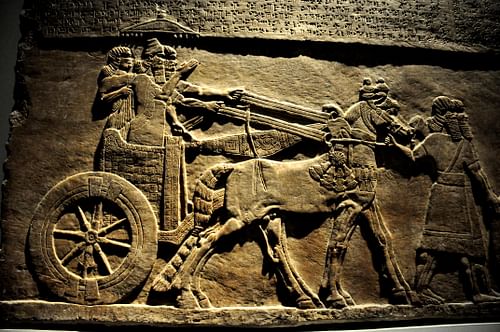
He also had at his disposal the largest, most well trained, and best equipped fighting force in the history of the world up to that time. The historian Kriwaczek describes how the army would have appeared to an opponent c. 740 BCE in the following passage:
He would have seen, in the centre of the formation, the main body of infantry, compact phalanxes of spearmen, their weapon points glittering in the sun, each arranged in ten files of twenty ranks. He would have marvelled – and perhaps trembled – at the discipline and precision of their maneuvering, a contrast to the relatively freewheeling manner of previous armies, for the reforms had introduced a highly developed and effective command structure. Infantrymen fought in squads of ten, each headed by an NCO, and grouped into companies of five to twenty squads under the command of a Captain. They were well protected and even better equipped, for Assyria was fielding the very first iron armies: iron swords, iron spear blades, iron helmets and even iron scales sewn as armour on to their tunics. Bronze weaponry offered no real contest: this new material, which was cheaper, harder, less brittle, could be ground sharper and kept a keener edge for far longer. Iron ore is not found in the north Mesopotamian heartland, so every effort had been made to put all nearby sources of the metal under Assyrian control. Assyrian spearmen were more mobile than their predecessors too. Rather than sandals, they now wore the Assyrian military invention that was arguably one of the most influential and long-lasting of all: the army boot. In this case the boots were knee-high leather footwear, thick-soled, hobnailed and with iron plates inserted to protect the shins, which made it possible for the first time to fight on any terrain however rough or wet, mountain or marsh, and in any season, winter or summer. This was the first all-weather, all-year army (236).
In addition there were archers and slingers, the archers equipped with the new composite bow which could fire long-range over the advancing infantry, and, at the forefront, the siege engines of the shock troops and “formations of chariots, mobile missile platforms, the ancient equivalent of tanks. These were no longer drawn at a slow pace by asses, but by much faster, larger, and more rugged animals: horses. Each chariot was powered by up to four of the beasts” (Kriwaczek, 237). This was the army that men like King Menachem of Israel saw threatening their cities. In Menachem's case, he chose to submit without resistance, paying Tiglath Pileser III 1,000 talents of silver. This transaction is mentioned in the Bible in II Kings 15:19 and I Chronicles 5:26, as well as in Assyrian inscriptions and, by it, Menachem saved himself and his city. He only had to swear loyalty and pay tribute to the Assyrian government to avoid having his city sacked and the people slaughtered. As Kriwaczek writes, “the decision, and the huge cost, paid off. Thanks to Assyrian support, Menachem was the only Israelite ruler during this anarchic period who managed to retain his position and die naturally in his bed” (239). Once loyalty was assured, regions such as Israel under Menachem were allowed to retain some autonomy and continue on with their lives as before.
In 736 BCE Tiglath Pileser III marched on the north and conquered the Medes and Persians, expanding his empire far into the region now known as Iran. At this point his empire encompassed the whole of Mesopotamia and the Levant, an area stretching from the Persian Gulf up to modern-day Iran, across to the Mediterranean Sea, and down through Israel. In 729 BCE a revolt broke out in the city of Babylon after the death of the king Nabonassar, who had been a loyal vassal, and Tiglath Pileser III marched on the city, put down the revolt, and executed the pretender to the throne. He then had himself crowned King Pulu of Babylon and officiated at the sacred festival celebrating the New Year. He was now king of both Assyria and Babylon and was at the height of his reign.
Death & Succession
After his success at Babylon, Tiglath Pileser III returned to his capital at Kahlu and his palace but did not remain there long. A revolt in Samaria broke out and he marched on the region to restore order. He died of natural causes before the engagement and was succeeded by his son Shalmaneser V (727-722 BCE) who continued his father's policies and maintained the empire but did not have his father's abilities in leadership, military skill, or politics. It was Tiglath Pileser III's younger son, Sargon II (722-705 BCE) who truly inherited his administrative genius and military talent. After five years of watching his older brother struggle to try to rule the empire as their father had, Sargon II deposed Shalmaneser V and took the throne. Although he did not expand the empire significantly beyond what his father had achieved, he did enrich the region through increased trade, significant relocation of populations to maximize productivity, and through his campaigns, which brought immense wealth into the empire in the form of looted gold, silver, and precious gems. Tiglath Pileser III's achievements laid the foundation for the future of the Assyrian Empire, which has come to be recognized as the greatest political and military entity of its time and the model on which future empires would be based.
